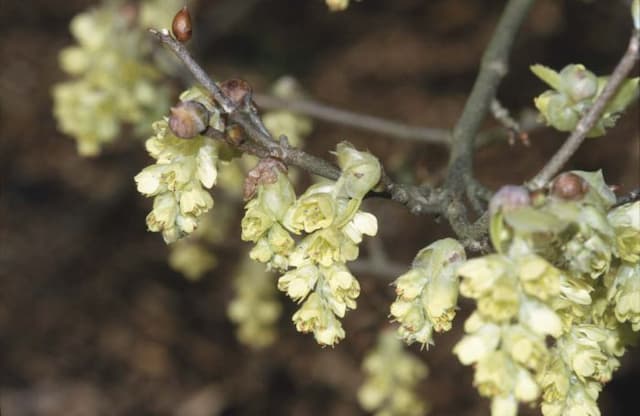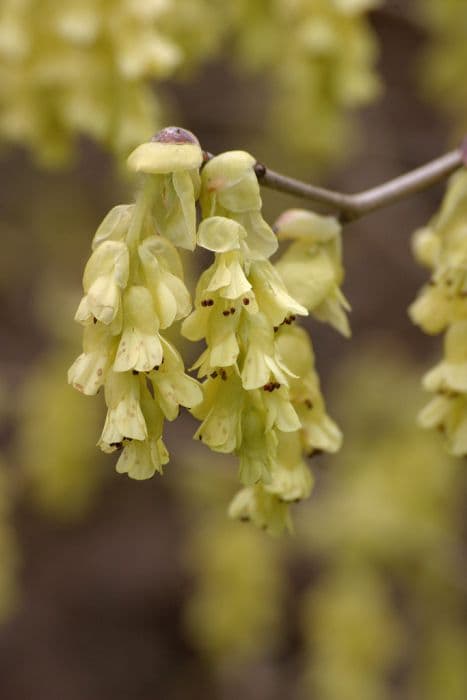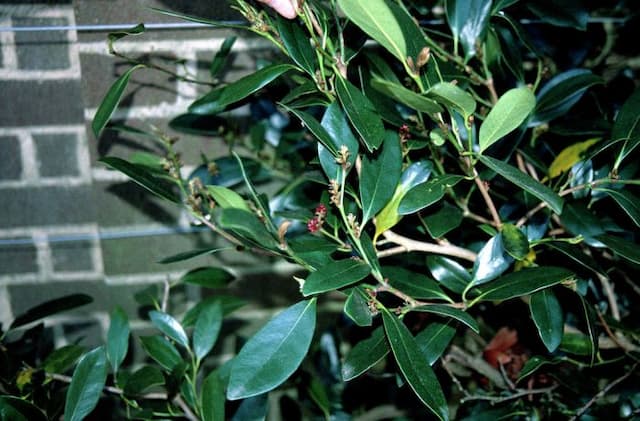Witch hazel 'Gingerbread' Hamamelis × intermedia 'Gingerbread'

ABOUT
'Gingerbread' is a spreading, moderately vigorous shrub up to 2.5m high and 3.5m wide, with ovate-rounded green leaves 10cm long and 6.5cm wide which are flushed with maroon-purple for a few weeks after they emerge before becoming dark green, then turning yellow in autumn, and slightly scented flowers with deep purplish red calyces and deep burnt orange petals about 2cm long, redder at the base, in late winter
About this plant
 Names
NamesFamily
Hamamelidaceae
Synonyms
Witch Hazel, Gingerbread Witch Hazel
Common names
Hamamelis × intermedia 'Gingerbread'
 Characteristics
CharacteristicsLife cycle
Perennials
Foliage type
Deciduous
Color of leaves
Green
Flower color
Coppery-orange
Height
12 feet (3.66 meters)
Spread
12 feet (3.66 meters)
Plant type
Shrub
Hardiness zones
5
Native area
Cultivar
Benefits
 General Benefits
General Benefits- Attractive Winter Blooms - Produces vibrant, fragrant flowers in the winter when most plants are dormant.
- Seasonal Interest - Offers year-round interest with flowers in winter and colorful foliage in fall.
- Wildlife Habitat - Provides shelter and food for birds and beneficial insects.
- Low Maintenance - Requires minimal pruning and is generally pest and disease resistant.
- Drought Tolerance - Once established, it has good tolerance to dry conditions, requiring less watering.
- Architectural Interest - Its distinctive, spreading shape can add structure to garden designs.
- Adaptability - Can thrive in a variety of soil types and environmental conditions.
 Medical Properties
Medical PropertiesThis plant is not used for medical purposes.
 Air-purifying Qualities
Air-purifying QualitiesThis plant is not specifically known for air purifying qualities.
 Other Uses
Other Uses- Photography - Witch Hazel 'Gingerbread' provides a beautiful subject for winter photography with its vibrant, spidery blooms against barren landscapes.
- Crafting Wreaths - The branches with their unique blooms can be gathered to craft distinctive winter wreaths.
- Nature-Inspired Jewelry - The flowers and seed pods can be used in creating botanical jewelry, preserved in resin.
- Natural Dye - Bark and leaves may be used to produce a natural dye for textiles, yielding colors depending on the mordant used.
- Winter Gardens - This plant adds structural interest and is used for color in winter gardens when few other plants are in bloom.
- Bonsai - Some enthusiasts may use Witch Hazel 'Gingerbread' for bonsai due to its interesting foliage and flowers.
- Witch Hazel Water Distillation - While typically recognized for its astringent properties, witch hazel water made from 'Gingerbread' can be used as a natural room fragrance or for aromatherapy.
- Landscaping - Used as a natural screen or hedge, offering privacy in garden designs with its dense foliage.
- Eco-friendly Insect Control - Some gardeners plant Witch Hazel 'Gingerbread' to help naturally repel certain pests without the use of chemicals.
- Floral Arrangements - The unique blossoms can be used fresh or dried in floral arts for table centerpieces and home decorations.
Interesting Facts
 Feng Shui
Feng ShuiThe Witch Hazel is not used in Feng Shui practice.
 Zodiac Sign Compitability
Zodiac Sign CompitabilityThe Witch Hazel is not used in astrology practice.
 Plant Symbolism
Plant Symbolism- Protection: Witch hazels are often associated with protective qualities, signifying the ability to safeguard oneself from adverse influences.
- Healing and Comfort: The medicinal uses of witch hazel, such as its application in treating skin conditions, translate symbolically into the plant representing healing and the easing of pain.
- Uniqueness and Beauty: The 'Gingerbread' variety, with its distinctive winter blooms, symbolizes the appreciation of unique beauty and the celebration of standing out from the crowd.
- Resilience: Blooming in the depths of winter, the witch hazel represents resilience and the ability to endure and prosper through hard times.
- New Beginnings: As one of the first plants to flower in the year, witch hazel symbolizes new beginnings and hope for the future.
 Water
WaterWitch Hazel 'Gingerbread' needs to be watered thoroughly, ensuring that the soil is moist but not waterlogged. In the growing season, usually spring and summer, water about once a week with about 1 to 1.5 gallons depending on the weather conditions, more frequently during hot, dry spells. In the fall and winter, reduce watering to every other week or when the soil feels dry to the touch. Always check the top inch of the soil for dryness before watering and adjust accordingly.
 Light
LightWitch Hazel 'Gingerbread' performs best in full sun to partial shade. Ideally, it should be planted in a location that receives at least four to six hours of direct sunlight per day but is protected from the harsh afternoon sun to prevent leaf scorch. Dappled sunlight under the canopy of taller trees is also a suitable spot for this plant.
 Temperature
TemperatureWitch Hazel 'Gingerbread' is hardy and can withstand temperatures as low as 0 degrees Fahrenheit and up to about 120 degrees Fahrenheit. However, the ideal temperature range for Witch Hazel is between 60 to 75 degrees Fahrenheit. It's important to protect the plant from extreme cold winds and very hot temperatures by providing a sheltered position if possible.
 Pruning
PruningWitch Hazel 'Gingerbread' benefits from pruning to remove any dead or damaged wood and to maintain an attractive shape. It's best to prune just after the plant has finished flowering, usually in late winter or early spring. Pruning at this time helps ensure that the next season's blooms are not compromised. Prune sparingly; removing only what is necessary.
 Cleaning
CleaningAs needed
 Soil
SoilWitch Hazel 'Gingerbread' thrives in well-draining, organically rich soil with a slightly acidic to neutral pH of 5.5 to 7. A good mix would be part garden soil, part compost, and part perlite or coarse sand to enhance drainage.
 Repotting
RepottingWitch Hazel 'Gingerbread' does not need frequent repotting and can be done every 3 to 5 years, or when it outgrows its current container, to refresh the soil and give the roots more room to grow.
 Humidity & Misting
Humidity & MistingWitch Hazel 'Gingerbread' prefers average to high humidity levels, but it is quite adaptable and can withstand lower humidity conditions typical of temperate climates.
 Suitable locations
Suitable locationsIndoor
Place in bright, indirect light and maintain humid conditions.
Outdoor
Choose a sunny to partial shade location and mulch well.
Hardiness zone
5-8 USDA
 Life cycle
Life cycleThe life of the Witch Hazel 'Gingerbread' begins with seed germination, typically requiring exposure to winter temperatures before they will sprout, a process called stratification. After sprouting, the young seedlings establish a root system and grow into juvenile plants, developing the characteristic broad leaves. As it matures, 'Gingerbread' enters the vegetative stage, marked by rapid growth and the development of the distinctive, fragrant, ribbon-like flowers that bloom in winter or early spring before the foliage emerges. Following flowering, the plant enters the reproductive stage, producing small, capsule-like fruits that split open in the fall to release seeds, perpetuating the cycle. The plant then enters a period of dormancy during the colder months, conserving energy for the next growth cycle. Throughout its life, proper care including adequate sunlight, pruning, and soil conditions will promote healthy growth and flowering in successive years.
 Propogation
PropogationPropogation time
Early Spring
The most popular method of propagation for Hamamelis × intermedia 'Gingerbread', commonly known as the Witch Hazel 'Gingerbread', is through softwood cuttings. This process is typically done in late spring or early summer when new growth is still flexible and not fully matured. To propagate by cuttings, a gardener would cut a piece of the stem about 4 to 6 inches (10 to 15 centimeters) long, making sure that it has several leaves. The lower leaves are removed and the cut end dipped into a rooting hormone before planting the cutting into a well-draining growing medium. The cutting should then be kept in a humid environment with indirect light until it roots, which may take several weeks, after which it can be transplanted into the garden.









